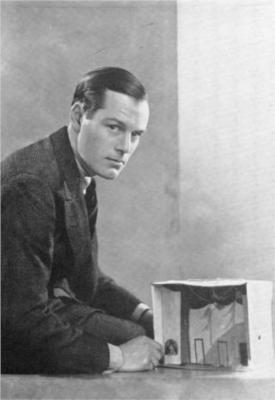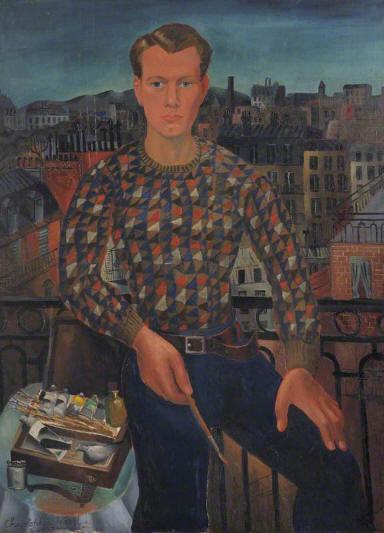 John Christopher Wood (7 April 1901 – 21 August 1930), also known as
Kit Wood, was an
English
painter born in
Knowsley, near
Liverpool.
John Christopher Wood (7 April 1901 – 21 August 1930), also known as
Kit Wood, was an
English
painter born in
Knowsley, near
Liverpool.Queer Places:
University of Liverpool, Liverpool L69 3BX, Regno Unito
Académie Julian, Passage des Panoramas, Paris, Francia
All Saints, Broad Chalke, Salisbury, Regno Unito
 John Christopher Wood (7 April 1901 – 21 August 1930), also known as
Kit Wood, was an
English
painter born in
Knowsley, near
Liverpool.
John Christopher Wood (7 April 1901 – 21 August 1930), also known as
Kit Wood, was an
English
painter born in
Knowsley, near
Liverpool.
Christopher Wood was born in Knowsley to Doctor Lucius and Clare Wood. He was educated at Marlborough College in Wiltshire, then briefly flirted with medicine and architecture at Liverpool University before pursuing an artistic career.[2]
At Liverpool University, Wood met Augustus John, who encouraged him to be a painter. The French collector Alphonse Kahn invited him to Paris in 1920.[3] From 1921 he trained as a painter at the Académie Julian in Paris, where he met Picasso, Jean Cocteau, Georges Auric and Sergei Diaghilev.[2][3] He travelled around Europe and north Africa between 1922 and 1924.
By the 1920s his father was running a general practice in Broad Chalke, Wiltshire, and Wood painted a series of canvases there including Cottage in Broadchalke, Anemones in a Window, Broadchalke, and The Red Cottage, Broadchalke.[2]
Wood was bisexual.[7] In 1921, at the age of eighteen, he was invited to Paris by the homosexual Alphonse Kahn, who lived on the Avenue du Bois de Boulogne. Wood took up the invitation and attended a Parisian art school.
In the early summer of 1921, Wood met José Antonio Gandarillas Huici (1885–1970), a Chilean diplomat. Gandarillas, a married homosexual fourteen years older than Wood, lived a glamorous life partly financed by gambling. Their relationship lasted through Wood's life, surviving his affair with Jeanne Bourgoint. Under Gandarillas’ sponsorship, Wood moved into a studio of his own (at first on the rue des Saints-Pères and then on the rue Balzac). They also travelled widely together. With Gandarillas in London, Wood met Ivor Novello and became the object of the painter Álvaro Guevara’s romantic interest. (Guevara would later marry Wood’s ex-fiancée Meraud Guinness.) In 1922 Gandarillas took him to Tunisia, Sicily (Taormina), Greece, Constantinople and Smyrna; then to Karlsbad, where both convalesced after bouts of malaria.

Self Portrait 1927
Christopher Wood (1901–1930)
Kettle's Yard, University of Cambridge

Boy with cat, portrait of Jean Bougoint by Christopher Wood, 1926
Brodie Castle, Forres, Scotland
Back in Paris, Gandarillas introduced him to opium, and in 1924 he met Jean Cocteau, who told him he had more talent for painting than anyone he knew. (So much for Picasso.) Late in 1925, Wood discussed with Serge Diaghilev an idea for a ballet to be called English Country Life; the music was to be by Constant Lambert. Diaghilev encouraged Wood at first, but eventually the project fell through. Meanwhile, in 1926, Wood acquired a girlfriend – none other than Jeanne Bourgoint, the distaff half of Cocteau’s enfants terribles. Picasso visited his studio and, genuinely impressed, recommended him to Diaghilev, who duly commissioned him to design Romeo and Juliet. However, Wood eventually resigned – he was not really up to the job – and the work was given to Joan Miró and Max Ernst. Later, though, Boris Kochno asked him for scenery for a piece called Luna Park, set to music by Lord Berners, for what was left of the Ballets Russes.
In 1926 he became a member of both the London Group and the Seven and Five Society plus meeting and befriending Ben and Winifred Nicholson. The Nicholsons' dedication to his work had a great influence and they subsequently painted together in Northumberland and Cornwall, then exhibited together at the Beaux Arts Gallery in April–May 1927.[3] Like Nicholson, Wood admired Alfred Wallis whom they met on a trip to St Ives, and whose primitivism influenced Woods' stylistic development.[3] He painted coastal scenes, and his finest works are considered to be those painted in Brittany in 1929. He claimed that his "mother's people were Cornish and that he got his love of the sea and for boats from his Cornish ancestry".[4]
In 1927 his plans to elope and marry heiress Meraud Guinness were frustrated by her parents whereupon he required emotional support from Winifred Nicholson. (Meraud went on to marry Chilean painter Álvaro Guevara in 1929.)[3] Wood also had a liaison with a Russian émigrée, Frosca Munster, whom he met in 1928.[3][8]
Through Gandarillas, Wood had made many close friends, most of them artists and many of them fellow homosexuals. In Marseille and Vence, the couple’s company helped René Crevel in his long recuperation from tuberculosis. And a stay in St Malo in 1929 was enlivened by the presence of the designer Christian Bérard and the poet Max Jacob. Indeed, after Wood’s sudden and unexpected death – he threw himself under a train on 21 August 1930 after lunch with his mother in Wiltshire – it is said that the individual who was most affected, after Wood’s mother herself, was Max Jacob.
In April 1929 Wood held a solo exhibition at Tooth's Gallery in Bond Street, London where he met Lucy Wertheim at a private view. She purchased a picture and soon became one of his biggest supporters, buying up his work.[3] For his part Wood apparently appreciated the support, telling Wertheim at her birthday party that:
I know that my future as a painter from now on will be bound up with your own, and I shall become great through you![5]
In May 1930 he had a largely unsuccessful exhibition with Nicholson at the Georges Bernheim Gallery in Paris. In June and July he made a second sojourn to Brittany to create new work. Later in July Wertheim travelled to meet Wood in Paris, to choose the paintings for a one-man show that would be the opening exhibition at her new Wertheim Gallery in October.[3] While discussing the exhibition over lunch the day after her arrival, Wood issued her with an ultimatum: "I want you to promise to guarantee me twelve hundred pounds a year from the time of my exhibition, one hundred pounds a month being the least I can live on. If I can't have this sum I've made up my mind to shoot myself". When she complained, he begged her forgiveness, and they went to review the paintings again. Following his death in August the show was cancelled; it was eventually staged as a memorial show at another gallery.[6]
By 1930, addicted to opium and painting frenetically in preparation for his Wertheim exhibition in London, Wood became psychotic and began carrying a revolver. On 21 August he travelled to meet his mother and sister for lunch at 'The County Hotel' in Salisbury and to show them a selection of his latest paintings. After saying goodbye he jumped under a train at Salisbury railway station, although in deference to his mother's wishes it was reported as an accident.[2][3]
Christopher Wood is buried in the churchyard of All Saints Church in Broad Chalke. His gravestone was carved by fellow artist and sculptor Eric Gill.[2]
Although his planned exhibition at the Wertheim gallery was cancelled on his death, a posthumous exhibition was held in February 1931. This was followed by an exhibition at the Lefevre Gallery in 1932.
The 1938 Venice Biennale included some of his paintings, and later the Redfern Gallery (part of the New Burlington Galleries) compiled a major retrospective.
My published books: